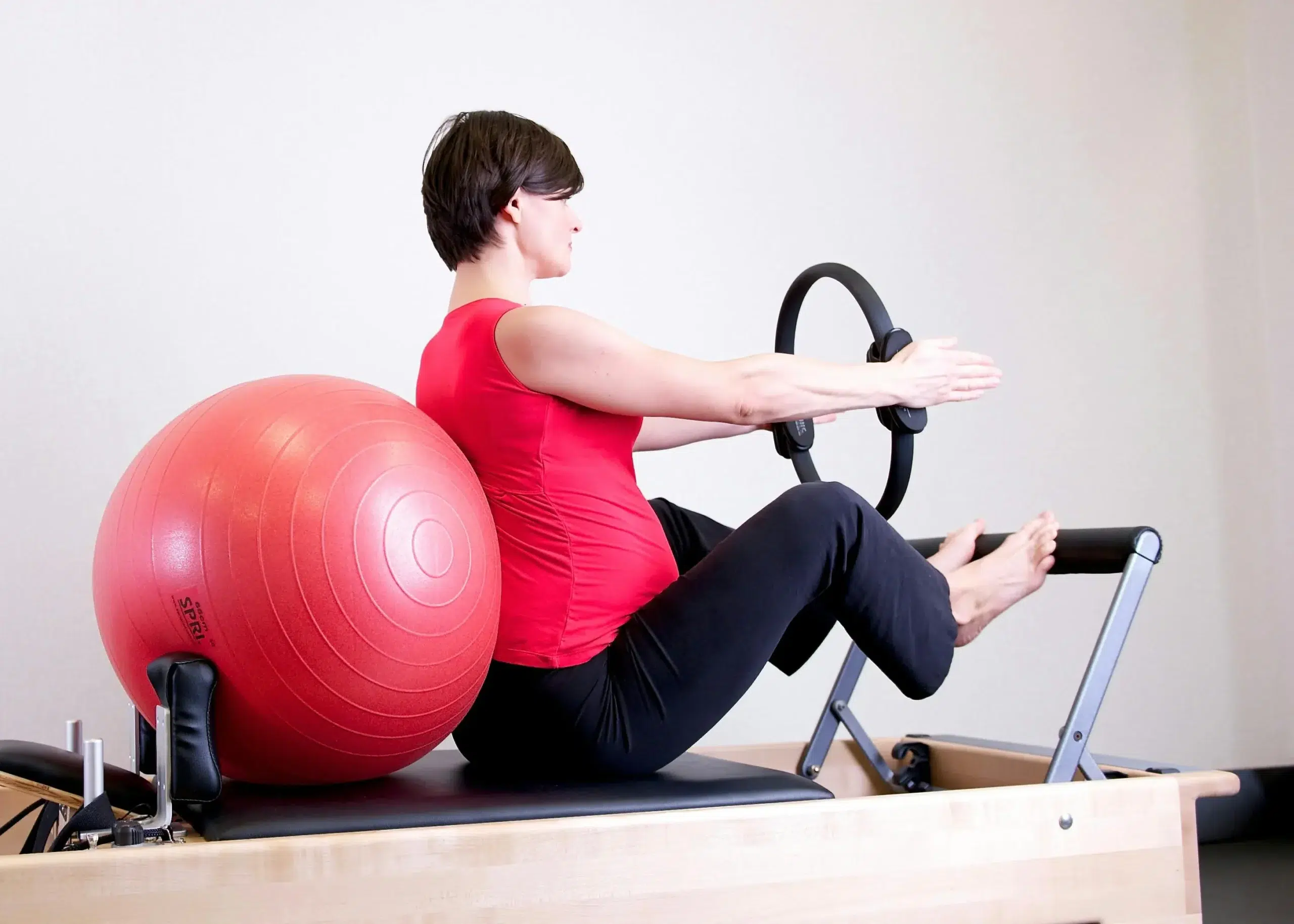If you’re pregnant and starting to feel the weight (literally) of carrying a growing baby, you’re probably wondering how to stay comfortable and support your body through all these changes. One thing that might not be on your radar yet is your pelvic floor—those muscles that do a lot of work behind the scenes to support your growing belly, control your bladder, and even help during childbirth. Pregnancy pelvic floor exercises can be a game-changer, not just for comfort during pregnancy, but also for labor and recovery afterward.
In this guide, we’ll break down what pelvic floor exercises are, why they matter during pregnancy, and how to do them safely and effectively. By the end, you’ll know exactly how to strengthen these muscles, manage common pregnancy symptoms like bladder leaks, and set yourself up for a smoother postpartum recovery. Let’s jump into what you need to know to keep your pelvic floor in tip-top shape during pregnancy.
What Is the Pelvic Floor and Why Is It Important During Pregnancy?
First, let’s explore what the pelvic floor is and why it’s important during pregnancy. The pelvic floor is a group of muscles that stretch like a hammock at the base of the pelvis. These muscles support important organs like the bladder, bowel, and uterus. During pregnancy, the pelvic floor muscles work harder as they support the many physical and physiological changes that occur.
The pelvic floor also plays a key role in bladder and bowel control. Strong pelvic floor muscles can make it easier to manage the added weight and pressure during pregnancy and can help prevent issues like bladder leaks and pelvic organ prolapse, which sometimes happen as a result of changes to the body in pregnancy and postpartum.
Why are Pelvic Floor Exercises Important During Pregnancy?
Pelvic floor exercises during pregnancy are important for a number of reasons. Not only can they help you avoid uncomfortable issues like urinary incontinence (those little leaks when you sneeze or cough), but they also make it easier for your body to handle the stress of carrying extra weight, placenta, growing baby, change in blood volume. Plus, a strong pelvic floor can help you recover more quickly after childbirth, whether you deliver vaginally or by C-section.
Many people during pregnancy also experience pelvic discomfort, back pain, and even pelvic girdle pain as their body adjusts to pregnancy. Strengthening the pelvic floor can help reduce some of this discomfort by supporting your lumbo pelvic region and stabilizing the pelvis.
In short, focusing on pelvic floor exercises for pregnant people can lead to a more comfortable pregnancy, smoother labor, and quicker postpartum recovery.
How to Do Pelvic Floor Exercises During Pregnancy
If you’ve never done pelvic floor exercises before, don’t worry—they’re simple and can be done just about anywhere, without any equipment. The most well-known exercise for the pelvic floor is the Kegel, but there are a few different ways to engage and strengthen these muscles.
Here’s a step-by-step guide on how to do basic pelvic floor exercises for pregnancy:
1. Kegel exercises
Kegels are a great exercise for connecting with your pelvic floor. While strengthening these muscles is important, it’s equally crucial to focus on relaxing and lengthening them. Both concepts support better stability and function, particularly during pregnancy. If your pelvic floor is tense, Kegels alone may not provide relief. Practicing both contraction and relaxation will help ease tension, reduce pain, and prepare the body for birth. Below is a step-by-step guide on how to do Kegels properly:
- Step 1: Find a comfortable sitting or lying position.
- Step 2: Take a deep breath and, as you exhale, imagine pulling your pelvic floor muscles upward, as if you’re trying to stop yourself from urinating. Hold this contraction for about 3 to 5 seconds.
- Step 3: Relax your muscles completely and rest for a few seconds before repeating. Aim to do 10 to 15 repetitions.
Try to avoid holding your breath or tightening your abdominal, buttock, or thigh muscles while doing Kegels. The focus should be entirely on the pelvic floor.
Remember, relaxation is just as important as contraction. Be mindful to fully release and relax your pelvic floor between repetitions to prevent over-tension and improve overall function.
2. Pelvic tilts
Pelvic tilts are great for strengthening the pelvic floor and helping with posture, which can take a hit during pregnancy as your belly grows.
- Step 1: Start by lying on your back with your knees bent and feet flat on the floor.
- Step 2: Flatten your lower back against the floor by tightening your abdominal muscles and tilting your pelvis slightly upward. This movement should feel like you’re gently tucking your tailbone under.
- Step 3: Hold the position for a few seconds, then release. Repeat this move 10 to 15 times.
Pelvic tilts can also be done on all fours (on your hands and knees) to reduce any pressure on your lower back.
3. Squats
Squats are not only great for your legs and glutes, but they also engage your pelvic floor muscles.
- Step 1: Stand with your feet about hip-width apart.
- Step 2: Slowly lower yourself into a squat by bending at your knees and hips, as if you’re sitting back into a chair.
- Step 3: As you come back up to a standing position, squeeze your pelvic floor muscles, like you would in a Kegel.
Focus on your form and avoid rounding your lower back or letting your knees cave in as you squat.
4. Bridge pose
This yoga-inspired move strengthens both the pelvic floor and your glutes, which helps support your lower back during pregnancy.
- Step 1: Lie on your back with your knees bent and feet flat on the floor, hip-width apart.
- Step 2: Press your feet into the ground and slowly lift your hips toward the ceiling while squeezing your pelvic floor muscles.
- Step 3: Hold the position for a few seconds before lowering back down.
Repeat the bridge pose 10 to 15 times, focusing on lifting your hips slowly and with control.
5. Child’s pose with pelvic floor relaxation
- Step 1: Kneel on the floor and sit back on your heels. Extend your arms forward and lower your chest toward the ground, coming into child’s pose.
- Step 2: As you breathe deeply, focus on relaxing your pelvic floor muscles with each exhale. Let your hips sink down toward your heels, releasing any tension in the pelvic area.
Hold this position for a few minutes, breathing slowly and fully.
When to Start Doing Pelvic Floor Exercises During Pregnancy
You can start doing pelvic floor exercises at any point during your pregnancy, and it’s generally safe to continue throughout all three trimesters. In the first and second trimesters, the focus is on building strength and stability in your pelvic floor, which helps support your body as it adapts to the physical changes of pregnancy. As you enter the third trimester, the emphasis shifts towards relaxing and lengthening the pelvic floor muscles, along with hip-opening exercises and gentle stretching to prepare for childbirth. As always, it’s a good idea to check with your healthcare provider before starting any new exercise routine, especially if you’re experiencing complications or discomfort
Starting early can help you build a strong foundation, which will be especially beneficial as your body starts to change and carry more weight. If you’re in your second or third trimester and haven’t started yet, it’s not too late to begin. Even a few minutes of pelvic floor exercises a day can make a difference.
How Often Should You Do Pelvic Floor Exercises During Pregnancy?
The great thing about pelvic floor exercises is that they don’t require much time or effort, and you can do them almost anywhere—whether you’re sitting at your desk, watching TV, or lying in bed.
Aim to do pelvic floor exercises 2 to 3 times a day. For Kegels, try to complete 10 to 15 repetitions per session, holding each contraction for 3 to 5 seconds. However, it’s important to note that Kegels may not be beneficial for everyone, especially if your pelvic floor is already tense. In those cases, focusing on relaxation and lengthening exercises might be more helpful. As you get stronger and more comfortable with these exercises, you can gradually increase the hold time and the number of repetitions.
Consistency is key, so finding ways to incorporate these exercises into your daily routine can help you stay on track. For example, you might decide to do your Kegels or relaxation techniques during daily activities like brushing your teeth or while sitting in the car.
Benefits of Pelvic Floor Exercises During Pregnancy
The benefits of doing pelvic floor exercises during pregnancy are numerous, and they go far beyond just preventing bladder leaks. Here’s what you can expect from keeping up with these exercises:
1. Improved bladder control
One of the biggest perks of pelvic floor exercises is better bladder control. Many pregnant women experience some degree of urinary incontinence, especially later in pregnancy when the baby is pressing down on the bladder. Strengthening your pelvic floor muscles can help you avoid those “oops” moments when you sneeze, cough, or laugh.
2. Reduced risk of pelvic organ prolapse
A strong pelvic floor helps support your organs and reduces the risk of pelvic organ prolapse, which can sometimes happen after childbirth. Pelvic organ prolapse occurs when the bladder, uterus, or bowel shifts out of its usual place and presses against the vaginal wall. Keeping your pelvic floor muscles strong can help prevent this from happening.
3. Easier labor and delivery
A strong pelvic floor can also help make labor and delivery easier. During childbirth, you’ll need to rely on these muscles to push effectively, and the more control and strength you have, the better. On the flip side, being able to relax your pelvic floor muscles when needed can also make the pushing phase of labor smoother.
4. Faster postpartum recovery
Doing pelvic floor exercises during pregnancy can support a quicker recovery after giving birth. Whether you have a vaginal delivery or a C-section, strengthening your pelvic floor can help reduce the risk of complications like incontinence or pelvic organ prolapse, aiding in a smoother postpartum recovery.
Tips for Safe Pelvic Floor Exercises During Pregnancy
While pelvic floor exercises are generally safe during pregnancy, it’s important to listen to your body and avoid pushing yourself too hard. Here are some tips to keep in mind:
- Focus on proper form: Make sure you’re doing the exercises correctly to avoid straining your back or other muscles. If you’re unsure, consider working with a physical therapist who specializes in pregnancy.
- Don’t overdo it: More isn’t always better. Start slow and gradually increase the intensity as you get stronger.
- Breathe: It’s easy to hold your breath when doing pelvic floor exercises, but it’s important to keep breathing throughout each movement to avoid unnecessary pressure on your abdomen.
- Stay comfortable: If you’re ever in pain or discomfort while doing these exercises, stop and talk to your healthcare provider.
Ready to start? Contact Indigo Physiotherapy today to schedule an appointment and learn more about pelvic floor therapy during pregnancy and postpartum physical therapy.







